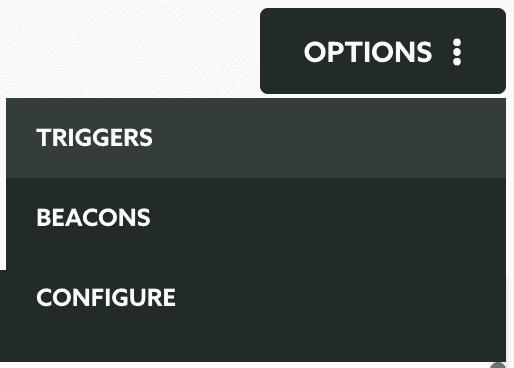Create Triggers
In these pages you'll learn how to create a geo-trigger.
In any of your apps expand the menu item Locations and click in Geo-Zones:

Then click in the geo-zone you would like to manage from the list of geo-zones:

Then expand the Options menu and click in Triggers:

In this page you'll find a New Trigger button in the top right corner, click on it to proceed:

This will open the geo-trigger composer, where you'll setup an interaction with a user that visits the geo-zone or a beacon in that geo-zone. This area is divided by the following tabs:

Setup
You should start by naming your trigger in the following field:

If you are using beacons, you can create a trigger for when you enter or exit the vicinity of a beacon. If you would like to use a beacon instead of the whole geo-zone, toggle the following option:
![]()
If you choose to use a beacon, you will need to select a previously created beacon:
![]()
Frequency
In this tab, you will provide the information for when and how often this trigger should be executed. Go ahead and select the frequency in the following field:

If you want it to be triggered only one time, select the option Only once when a user:

If you select this option, you can also provide the occasion when it should be triggered. This allows you to create geo-triggers that are only triggered once on a certain occasion:

If you want it to be triggered every time, select the option Every time a user:

When you select this option, you can also define in which occasion it should be triggered. This allows you to create geo-triggers that are triggered every time on a certain occasion:

Or if you want it to be triggered once every x amount of time, select the option If a user:

When you select this option you should also provide the interval of time:

Then you should select when it should trigger, if you want it to trigger when a user enters or leaves the geo-zone or in case you've selected to trigger based on a beacon, if it enters or leaves the beacon vicinity:

You can also set a Dwelling time for a trigger:

If provided this will delay the trigger for the amount of time you specify and your trigger will be cancelled if the user leaves the region/beacon before that delay (if you have selected the Enters this region/beacon) or enters that region/beacon before the delay (if you have selected Leaves this region/beacon). This will allow you to filter out users that either pass through your regions too often and too fast. It will also make sure that you only trigger messages if the user stays for a certain amount of time inside or outside your geo-zone or beacon.
And finally you can also specify if your triggers should be skipped on certain days of the week during the length of the trigger's duration:

Duration
This is an optional setup for your trigger. If you wish to provide time restrictions for your trigger, click in the Duration tab. Then to add a date limit to your trigger, you can provide a start and end date:

You can also provide a time range during which your trigger will be active throughout the day:

Please note that dates and times used in these fields will be saved and used according to the region's timezone.
Filters
Optionally you can also assign filters to your trigger. Through an advanced criteria, you are able to select certain group of users or devices that are eligible for a trigger, ignoring all the rest. Go ahead and click the Filters tab to set this up:

Learn more about how to setup a criteria in our guides located here.
Segmentation
It is also possible to automatically categorize users as these triggers get executed. This is extremely powerful if you want to categorize users based on their behaviour without having to necessarily include this functionality in your apps. To add segmentation rules, go ahead an open the Segmentation tab:

Learn more about how to setup segmentation rules in our guides located here.
Content
Finally in this area you can also select if you want to present content to the user when a trigger is executed. By default this will set to None and the user will not see anything as these triggers occur. To change that, open the Content tab and expand the content types selector:

From the list of available content select the Push Message:

Optionally, you can also reuse a previously created template as the basis for your message:

If you toggled that option, you will need to search for an existing template:

After picking one template, your selection will look like this:

When you're ready to create the trigger, make sure you click the Create Geo-Trigger button to save it:

Keep reading our guides and learn how to edit geo-triggers.